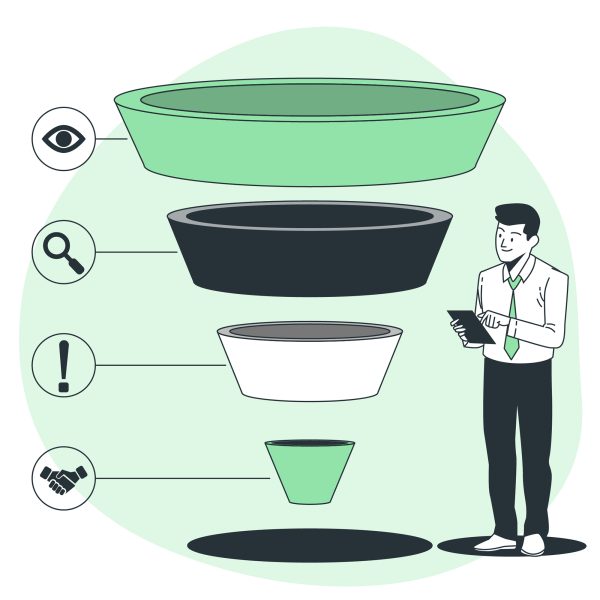Why everyone should understand sales funnels

Every marketer has heard of a sales funnel. But I am sure not every marketer truly understand how fundamental it is to understanding how we can improve the bottom line for our clients. I’m sure even other departments from your company are probably thinking, “Those are some weird tornado things marketers draw for fun and mean nothing. to us” But nothing can be farther from the truth. Understanding the funnel can not only improve communication with consumers but within the marketing team as well. So let’s dive into some funnels.
The Basic Funnel
There are many different types of funnels, with varying numbers of layers so we will keep it simple and make it four levels; awareness, consideration, conversion, and loyalty.
- Awareness: This is where the person is exposed to our brand but may not necessarily be in the market for our product.
- Consideration: This is where the person has been exposed and is in the market shopping around and looking to make a purchase. Often also called leads.
- Conversion: This is when the person takes an action like purchasing our product or service.
- Loyalty: This is when a person has become a repeat buyer of our product and may even be a so called “brand evangelist.”
Top Down
Now as marketers we can make campaigns to target each one of these parts of the funnels. Of course depending on our goals, we may want to build brand awareness, or generate leads but in the end marketing is about generating sales, and that is where all levels of marketers make mistakes.
Often marketers think its a funnel, so if we just increase the amount we put it, then everything below it will increase too. So we will get campaigns that target the top of funnel expecting an increase in sales at the bottom.
But if you ever tried pouring gas down a funnel all at once, it will it just spill out and those going down the funnel hasn’t changed. In business terms, just because we increase the input at the top of the funnel, doesn’t mean we will see significant change in our overall profit margin at the bottom.
Meaning we may spend a whole lot of money invested in campaigns that are targeting the top to see no profit increases and then your out of job.
To be fair this might not even be your fault, and your manager or the CMO has decided this is the strategy, but you get the short end of the stick as it is an impossible task.
Instead we need to shift our focus to the bottom of the funnel. This is where the money comes from and where we can have the most impact on sales.
Bottoms Up
Conversions
As marketers we are in a great position to optimize for conversions without having to request crazy budget increases or begging for price increases to our products. We have many options available to us.
If only 1% of people are converting, we can ask what prevents them from clicking buy? Is that our checkout page ask for to much information? Are we remarketing to abandon carts? Is the website optimized and easy to search for? These are things we can do to increase that 1% to 1.5% which is massive to the overall profit margin.
From a higher level position considering whether or not increasing a price can be a hard decision but one that will pay out. As mentioned before profit margin is changes much by top down funnels. But price increases wow.
A simple increase in prices can see radical changes in the overall profit margin. Even if we lost a small percentage of customers the long term growth is there.
The difficulty comes in determining whether the demand is there and that requires a lot of data and risk taking as it can also have the opposite effect.
Loyalty
Similarly with loyalty part of the funnel, these consumers are repeat buyers. That means they are always generating sales but only so long as we keep them.
Again we have so many options for us, such as promotions for repeat buyers, or developing communities and brand that is involved with its consumers directly by opening up channels to express and share how our products change their lives.
Even customer service representatives are so key to not only loyalty retention but generating leads and sales. Customer representatives are often fixing customers problems or being asked questions by current or inquiring customers.
Often customer service representatives are disconnected or see themselves disconnected from the sales process when they are key players in it.
If we have good service and treat our customers well they may stay feeling they have a good support system and continue to purchase or subscribe. While bad service can have the opposite effect and lose loyal or inquiring customers.
From a higher-level position CMOs and managers can work with customer relations teams to make sure there messaging and values are also conveyed when speaking to customers and reminding them of there importance in the sales process.
Collaboration for Success
I hope you have seen why the funnel is important for all levels of the marketing and sales process. It not only helps increase sales, but also ensures healthy communication with all levels in the process. It can also help develop better channels of communication with other departments, including our sales team.
If you like this type of content, please follow me on social media to get the latest updates here.